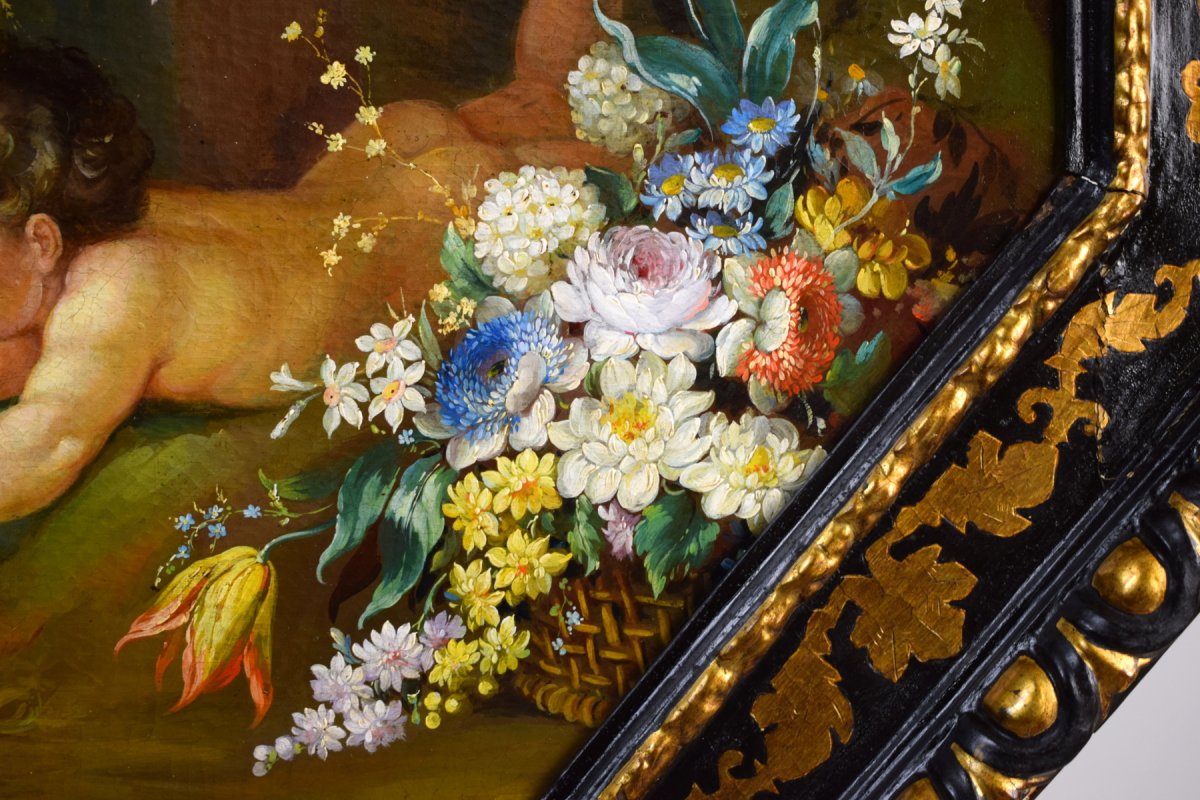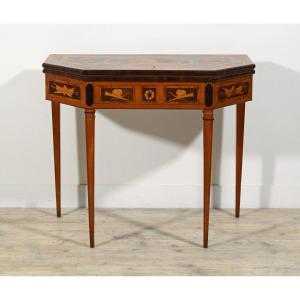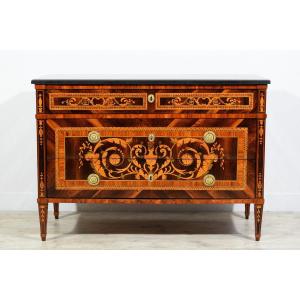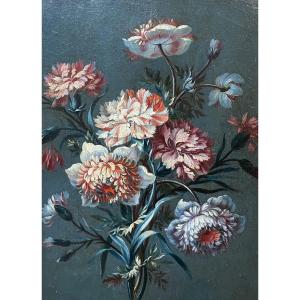Still life with cherubs, flower festoons and herma with faun
Oil on canvas, cm H 78 x W 95 without frame
Cm H 122,00 x W 106 x D 8 with frame
The work, painted in oil on canvas, octagonal in shape, represents a nature with three putti or cupids playing with flower festoons in a wooded environment in which is placed a herma with faun and, on the left, a large neoclassical marble vase, adorned with buffaloes with festoons and a large floral arrangement.The artist uses a bright color palette in which yellow, red and blue are well balanced with which brightens the flower garlands.
The herma comes from one of the first archaic forms of representation of the dwellings of a divinity that here must be identified with the faun, figure of the Roman mythology, divinity of the nature, the country, the flocks and the woods.He was a powerful and wild god, depicted with goat legs and horns, hirsute legs and hooves, while the bust is human, the bearded face and the expression mischievous.He wandered through the woods, often to chase the nymphs, while playing and dancing.It is one of the oldest Italic deities, derived from the god Pan of Greek mythology.Pan was a non-Olympic deity, with the appearance of a satyr, linked to forests and nature.He was the shepherd god, the god of the countryside and pastures.In some myths he is described as the oldest god of the Olympians: he had drunk with Zeus the milk from Amaltea, raised the dogs of Artemis and taught the divinatory art to Apollo.
The painting dates back to the 19th century, the work of a Roman author.
The canvas is close to similar compositions, with flowers and putti, which were established from the mid-seventeenth century in Rome to find widespread throughout the first half of the eighteenth century, in the Baroque era.
There are numerous authors who proposed this kind of representation, where putti and chubby cupids play and support prosperous garlands and compositions of flowers and fruit.Likewise, the herma with faun, or with other divinities, and mythological figures are often found side by side, around which the cupids joke.
Quite common, as shown by the works proposed here in comparison, is the painting performed with four hands: the putti and figures are made by an artist, while another deals with the representation of flowers and still lifes.One example is that of Mario de ' Fiori, pseudonym of Mario Nuzzi (Penna San Giovanni, 19 January 1603 - Rome, 14 November 1673), who owes his nickname to his famous compositions of flowers, a genre of which he was a great specialist.Mario de' Fiori collaborated with eminent Baroque painters active in Rome, such as Filippo Lauri (Rome 1623 - 1694) or Bernardino Mei (Siena, October 1612 - Rome, 1676). Famous are the four canvases of Palazzo Chigi with the Seasons that see the collaboration of Mario de' Fiori with Lauri, with Mei and with Carlo Maratta (Camerano, 15 May 1625 - Rome, 15 December 1713).
Carlo Maratta (Camerano 1625 - Rome 1713) was a central figure of Roman and Italian painting in the second half of the seventeenth century;during his life he was celebrated as the greatest painter of his time, also marking a large part of the artistic production of the following century.He often collaborated with some important workshops completing their floral arrangements.Among these, in addition to that of the aforementioned Mario Nuzzi, there are those of Giovanni and Niccolò Stanchi and that of Franz Werner von Tamm (1658-1724), a painter active in Rome between 1685 and 1695. Among the best examples are the magnificent mirrors, commissioned by Lorenzo Onofrio between 1660 and 1670 for the Palazzo Colonna, then moved in 1740 in the Great Gallery.Carlo Maratta was responsible for the making of the putti, while Mario de' Fiori and Giovanni Stanchi painted the garlands of flowers.The two painters of still life also made use of the study from life in the realization of the great variety of flowers, taking inspiration from those cultivated in the great garden of the Palace.
As for Niccolò Stanchi (1623/ 1690), the younger brother owner of the workshop after the death of Giovanni, we remember the mirrors in Palazzo Borghese, executed in 1675 in collaboration with Ciro Ferri (1634/ 1689).
In conclusion, the painting in question is to be considered as an example of the vast fortune that this kind of painting had in the seventeenth-eighteenth century and that lasted until the beginning of the nineteenth century, still commissioned by collectors who wanted to decorate their palaces with such kind of paintings from the subjects carefree and graceful.
The work presents canvas and frame, as well as an octagonal frame cassette of great value, baroque.It is possible that the author of the painting used a seventeenth-century canvas adapted to the typically Baroque subject.This could have been done on commission, at a time like the 19th century, when there was a revival of Baroque and Rococo at European level.The painter, as noted, is clearly inspired by the great Seventeenth and Eighteenth century masters of the genre, in particular, for the composition and putti, to Carlo Maratta and Mario de' Fiori and, probably belongs to that category of florists that in Rome knew remarkable fortune in the furnishing of the noble palaces especially after the unity of Italy.A nineteenth-century artist, therefore, but of great quality able to recreate and reinterpret with mastery the great seventeenth-century Roman art;an artist with excellent academic foundations that creates compositions from bright and lively colors and remarkable compositional balance.Unfortunately, the flowers of the Roman nineteenth century have not yet been the subject of careful studies and we hope that they can be soon in order to clarify figures and cultural paths.
We apologize for any errors in translation from Italian. Please click on the wordEXPERTISE to read the expertise in Italian
















































 Le Magazine de PROANTIC
Le Magazine de PROANTIC TRÉSORS Magazine
TRÉSORS Magazine Rivista Artiquariato
Rivista Artiquariato